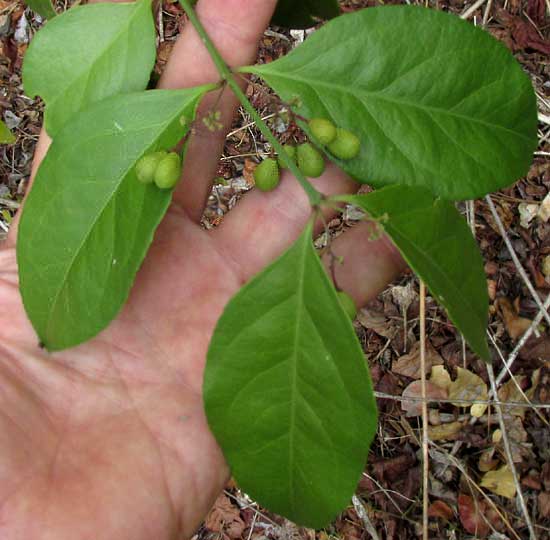Excerpts from Jim Conrad's
Naturalist Newsletter
from the June 12, 2016 Newsletter issued from Hacienda Chichen Resort beside Chichín Itzá Ruins; limestone bedrock; elevation ~39m (~128ft), N20.675°, W88.569°; central Yucatán state, MÉXICO
CROSSOPETALUM BUSH
Along an overgrown trail through the woods a slender, stiff-stemmed, belly-high bush bore pea-sized, green fruits, as shown below:

The fruits were immature, but such clusters issuing from the axils of opposite leaves rang some kind of bell with me. A closer look showed what appeared to be minuscule flowers among the fruits, shown below:

The bush's spindly, green stems and opposite, simple leaves reminded me of Euonymus bushes up North, bushes sometimes called Hearts-a-bustin' or Strawberry Bush. You can compare our present bush with a Euonymus in Mississippi at www.backyardnature.net/n/w/euonymus.htm
A good field mark for Euonymus bushes up North is that their slender, green, stiff stems are four-angled in cross section, with low ridges accentuating the stems' corners. Below, you can see this very feature on our Yucatan bush:

However, flowers on our Mississippi Euonymus looked very different. Still, just the stems and leaves made me think our bush was in the same family as Euonymus, the Staff-tree Family, or Celastraceae, so that's where I began looking.
Our green-stemmed bush is indeed a member of the Celastraceae, but it's not Euonymus, which mainly is a northern Temperate Zone genus. Our plant is CROSSOPETALUM PARVIFLORUM, found from southern Mexico south through Central America to Peru in South America. In rainier areas than ours it can grow over 25 feet high (8m). The fruits don't grow much bigger than those in our photos, but at maturity turn yellow or red,. A fruit with part of its flesh removed to show the bony seed inside is shown below:

I find no use stated for the bush, though in areas where it grows into a small tree its trunk is used for firewood and fenceposts.